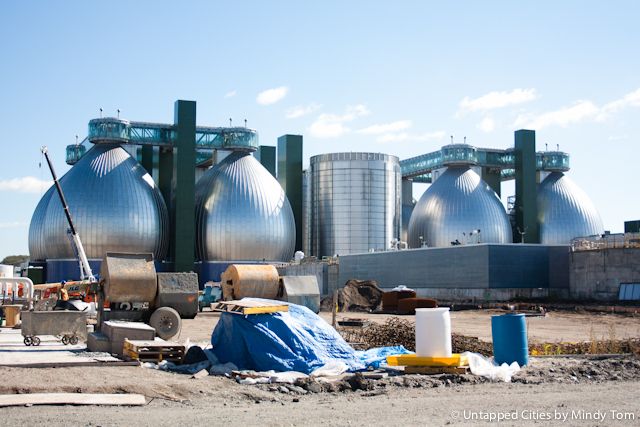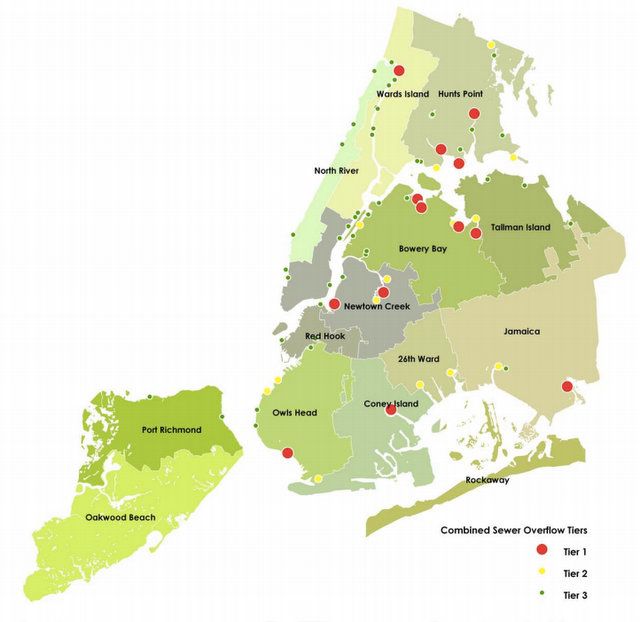A Salvaged Banksy Mural is Now on View in NYC
This unique Banksy mural goes up for auction on May 21st in NYC!



A modern sewage treatment plant: The Digester Eggs at Newtown Creek
Until 1992, ocean dumping was permitted in the Atlantic Ocean. According to Kate Ascher, author of The Works, New York City took its sewage (initially in raw form, later post-processing) to the Atlantic in two places — one 12 miles off the coast of New Jersey and another 106 miles out. The Jersey site was only 88 feet deep but the the other was just off the Continental Shelf at about 7500 feet deep. By 1986, new permits could not be issued for the 12 mile site.
The ban on ocean dumping began on December 31, 1991, which was part of Congress’ Ocean Dumping Act from 1972. The original act intended for the ban to begin 1982 but the deadline wasn’t achieved. On a side note, the ban specifically included Long Island Sound as part of the Ocean Dumping Act. While these environmental initiatives may seem to have occurred late to us now in hindsight, it’s important to remember that New York City only starting building its sewers in 1849 after a massive cholera outbreak. The first sewage treatment plant in the US wasn’t built until the late 19th century in Brooklyn. Until 1986, untreated sewage from Manhattan’s West Side went directly into the Hudson River, writes Ascher.
After the ocean dumping ban became effective, New York City’s sludge went by train (45 per day) on the “Poo-Poo Choo-Choo” to Sierra Blanca, Texas, a town close to the Mexican border. According to Ascher, “There, 90 miles southeast of El Paso, roughly 250 tons of waste would be spread atop the fields, at one of the biggest sludge dumps in the world. The locals welcomed the sludge, and found ways to live with the smell when the breeze came from the north: one said, ‘It smells like a hog farm,’ and another, ‘To me it smells like money.'” That being said, there have been various health and environmental impacts reported in connection to the Sierra Blanca dump site.
The last Poo-Poo- Choo-Choo train went to Sierra Blanca in 2001. The city processes sewage in one of 14 treatment plants, including the modern Digester Eggs at Newtown Creek which manages the wastewater from Lower Manhattan and Brooklyn. The digester eggs can process about 1.5 million gallons of sludge a day. A good portion of the ‘digested sludge’ is converted to fertilizer, reusable energy and gas and the remainder is typically shipped off to landfills. Some treatment plants have a “dewatering facility” which more fully treats the sludge, others do not and transfer their sludge to another plant for processing.
But still, not all of the sewage in New York City gets captured. In fact, New York City still has a combined sewer system, which mixes wastewater and stormwater. When it’s dry, the system works and both types of water arrive at the treatment plant. As of 2005, about half the time it rained the system overflowed and the sewage ended up in the harbor untreated. The stormwater issue is a key piece of Mayor Bloomberg’s PlaNYC, and remediation initiatives include underground reservoirs, sustainable green infrastructure like green roofs, bioswales and source controls.

Combined Sewer Outfalls along NYC Waterfront, via NYC.gov
The Poo-Poo Choo Choo became a plot line in a recent season of Billions when trains of sludge were sent to Texas as a political retaliation.
Subscribe to our newsletter